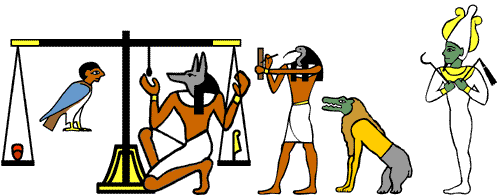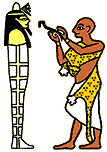|
|
Neferchichi's
Tomb
The Book of the Dead A preserved body, amulets, a funeral mask, a decorated coffin or even a sarcophagus, a tomb full of goodies, and a bunch of shabtis- isn't that enough to guarantee that the parts of the soul will live forever in the afterlife? Not quite. Another "must have" was a copy of The Book of the Dead. Even though it's called a book, it really wasn't. The Egyptians didn't have books with covers and bound pages. The Book of the Dead was actually a collection of spells and prayers written on papyrus scrolls. Before the mummy's spirit could reach the afterlife, it had to pass through a dangerous underworld known as Duat. Monsters, giant cobras, and lakes of fire were some of the dangers found in Duat. Along with the amulets wrapped up in the mummy and the spells painted on the coffin, the spells and prayers in the Book of the Dead helped the spirit make it safely through this perilous trip. The ultimate and final test for the spirit's voyage through Duat was The Weighing of the Heart. This test was always shown in the Book of the Dead. It shows the ba of the dead person watching the test, hoping to pass. Anubis stands under a scale and verifies that it's working correctly as the ibis-headed scribe god Thoth waits to record the results. The heart of the dead person is weighed against "the feather of truth," a symbol of Ma'at (the goddess of truth, justice, and order). If the heart weighs less, the spirit is free to go on to meet Osiris in the afterlife. But if the heart is heavy with sin, it is thrown to Ammut, "the devourer of the dead," who gobbles it up, denying the spirit an afterlife and causing it to cease to exist!
The funeral procession Since the sun appeared to die in the west every evening, it made sense that the dead should end there too. In fact, when the Egyptians spoke of "westerners," they were using their slang word for "dead people." So to get to the tomb in the necropolis, the Nile had to be crossed. The embalmers transported the mummy across the river on a boat, where it was picked up by the mourners on the other side. The mummy would be placed on a boat-shaped sled called a bier. This make-believe funeral barge was either pulled by oxen or it was just dragged by people. As the funeral procession made its trip to the tomb, servants carried food and drink, shabtis, the canopic jars, and the mummy's possessions. Several priests walked in the procession too, reciting spells and prayers from the Book of the Dead.

A person's social status was judged by how many mourners were present at the funeral. Sometimes, families would hire women to mourn at the funeral. They would wave their arms, throw dust in their hair, and weep. The better the performance, the more they were paid! Once the funeral procession arrived at the tomb, a ceremony called The Opening of the Mouth was performed on the mummy. A priest would touch the mummy's mouth with a special instrument that magically restored the mummy's senses, so that it could eat, drink, speak, and breathe when it got to the afterlife.
Finally, the mummy was placed in its tomb with all its possessions. The mourners would have a feast at the door of the tomb, and waste materials left over from the mummification process would be buried nearby. The mummy, now safe from decay and protected by spells and amulets, would hopefully soon join Osiris in the afterlife!
|



